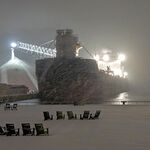TOareaFan
Superstar
What does having no fare booth/collection have to do with 24/7 operation?
I think the implication is that it lowers the amount of staff that is needed to operate. The argument usually goes that the lower the variable cost the more of your fixed cost you can recover by extending your hours of operation.
My bet is that anyone who would be using a line at that time is likely a metropass holder anyway and you are not likely going to drive more revenue with 24/7 operating stance.




